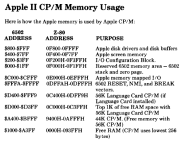Wawavoun
Experienced Member
Hello,
My question is almost in the subject.
I want to run some assembly code on a Z80 located in a Microsoft Softcard.
This code include IN and OUT statement followed by a 8 bits address. I believe these instructions use the lower byte of the address bus and the ioreq pin of the Z80 to say to the hardware that this operation do not involve the memory but some special io devices.
On the Microsoft Softcard a quick look at the schematic show the ioreq pin is not wired... So I think IN and OUT instructions has no chance to work. Can you confirm ?
Second : what is the best way to modify the code ?
I think I can use LDA/STA at the right address in place. Will this be correct ?
Thanks for your advices and help.
Regards.
Philippe
My question is almost in the subject.
I want to run some assembly code on a Z80 located in a Microsoft Softcard.
This code include IN and OUT statement followed by a 8 bits address. I believe these instructions use the lower byte of the address bus and the ioreq pin of the Z80 to say to the hardware that this operation do not involve the memory but some special io devices.
On the Microsoft Softcard a quick look at the schematic show the ioreq pin is not wired... So I think IN and OUT instructions has no chance to work. Can you confirm ?
Second : what is the best way to modify the code ?
I think I can use LDA/STA at the right address in place. Will this be correct ?
Thanks for your advices and help.
Regards.
Philippe

